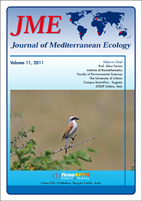JME 2011
Cytotoxicity and mutagenic effects of soil radionuclides on some black sand plant species
M.S.A. Soliman, A.K. Hegazy*, S.K. Goda , M.H. Emam and A.A. Al-Atar
Abstract: Three plant species (Cakile maritima Scop., Senecio glaucus L. and Rumex pictus Forssk) were selected from three black sand habitats along the Mediterranean coast in Egypt for cytogenetic studies and to recognizes the mechanism by which plants withstand high concentration of the absorbed radionuclides through determination of the electrophoratic banding pattern of protein and amino acid profiles. The study showed that exposure of the study plant species to soil radionuclides causes decrease in the percentage of prophase and prophase to metaphase ratio, while the percentage of anaphase and telophase increases with soil radioactivity. The results revealed chromosomal aberrations, e.g., C-metaphase, star metaphase, chromosome stickiness at metaphase stage, C-anaphase and chromosomal breaks at the different mitotic stages with fluctuation in the index of mitotic phases. High radionuclide content of plants causes alterations in the bands relative mobility and intensities, expression of new proteins and suppression of some proteins. Study of amino acid profile of plants indicated that radioactive elements stimulate the biosynthesis of some amino acids e.g. proline, cysteine, serine and thereonine while inhibit some other amino acids such as arginine. Aspartic acid is the most abundant amino acid in the three study species.
Keywords: Black sands; Mediterranean; Chromosomal aberrations; Proteins; Amino acids; Uranium; Thorium.
Importance of road proximity for the nest site selection of the Red-backed shrike (Lanius collurio) in an agricultural environment in central Italy
Federico MORELLI
Abstract: The effect of road proximity on the breeding habits of the Red-backed Shrike (Lanius collurio) was investigated in a farmland landscape of the Marche Region (Central Italy). Surface and the density of shrubs, distance from buildings, distance from roads and type of roads, and elevation of the terrain around nesting sites were the factors considered. The results indicate that this species prefers to nest in shrubs near to countryside roads (76% of the nests were constructed less than 25 meters from roads). It ignores shrubs with apparently similar characteristics which are located away from roads. It is reasonable to argue that suitable shrubs for nesting and the contemporary presence of bare soil for hunting, both of which exist close to countryside roads, might represent the favourable components of the breeding habitat selections made by the Red-backed Shrike.
Keywords: Lanius collurio, nesting distribution, suitable shrubs, roads
Potential protective effects of vitamin E on diazinon-induced DNA damage and some haematological and biochemical alterations in rats
Venees F. Yassa, Shenouda M. Girgis and Iman M.K. Abumourad
Abstract: Diazinon (DZN), is a commonly used organophosphorous (OP) pesticide to control a variety of insects in agriculture and in the environment. Vitamin E is a primary antioxidant that plays an important role in protecting cells against toxicity by inactivating free radicals generated following pesticides exposure. Therefore, the present study was undertaken to investigate the possible protective effect of vitamin E against DZN- induced adverse effects on haematological and biochemical indices and on genotoxicity using comet assay and micronucleus test for measuring the DNA damage. The tissue DZN residues in liver, kidney and muscle of the rats were determined. Vitamin E (200 mg/kg, twice a week), diazinon (10mg/kg/ day, once a day), and vitamin E (200mg/kg, twice a week + diazinon (10mg/kg/day, once a day) combination were given to rats (n= 10) orally via gavage for 4 weeks. The results revealed that DZN administration significantly decreased Hb concentration, RBCs count and PCV values. Meanwhile, a significant increased in WBCs, ALT, AST and total cholesterol was detected. However, vitamin E supplementation together with DZN improves these alterations. DZN residues level is highest in the kidney than that in liver and muscle tissues. Administration of vitamin E together with DZN reduces the residual values in the examined tissues. A significant increase in tail length of comets from blood cells as well in the frequency of micronucleated cells (MNCs) following DZN administration was achieved. Co-administrated vitamin E along with DZN resulted in decrease in tail length of comets and the percentage of MNCs compared to DZN alone treated rats. The increase in frequency of MNCs and tail length of comets confirm the genotoxicity of DZN. Vitamin E, on the other hand, was observed to repair the genotoxicity and improves the haematological and biochemical changes induced by DZN. It can be concluded that vitamin E has protective effect against DZN adverse effects and supplementation of vitamin E might be beneficial to DZN exposed populations.
Keywords: Vitamin E, protective, diazinon, DNA damage, haematological, biochemical, genotoxicity, comet assay, rats.
